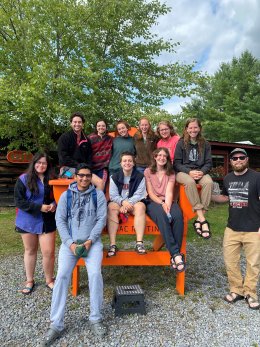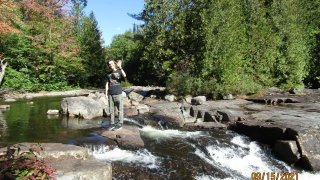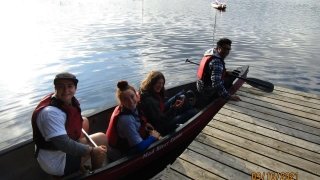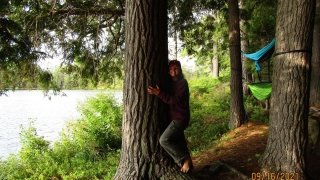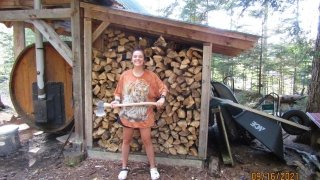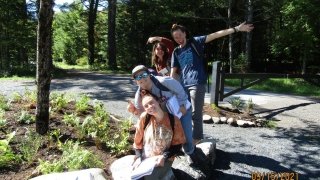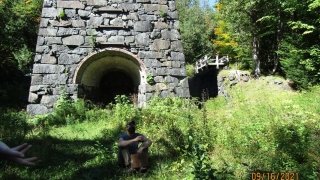The Adirondack Classroom
Bri Duggan & Lauren Gulbicki
“FoooorWARD!” commands Carrie, our guide from Adirondac Rafting Company. In response, six Arcadians drive their paddles into the wild waters of the Hudson River. Our raft dives down a wave and immediately rises, splashing glacial water on our smiling faces. Clearing the water from our eyes, we gaze up at the blend of evergreens and hardwoods just beginning to change color.
As a component of the Adirondack Semester, students go on excursions such as rock climbing, rafting, and backpacking trips to deepen our connection to the park and develop a sense of place. So last Saturday, we Arcadians left behind the peaceful waters of Lake Massawepie to experience the thrill of whitewater rafting on the upper Hudson.
On calmer waters, Carrie shifts from raft guide to tour guide, displaying her knowledge of the land around us. “We’re coming up on Osprey’s Nest,” she says. Carrie tells us how this Class III rapid was named by loggers in the 1800s who managed this section of river. Our ears perk up at the familiarity of this information because we had just finished learning about the history of logging in our “Land-Use Change in the Adirondacks” class, taught by Pete Pettengill. We were no ordinary tourists. We came bearing the knowledge that the beautiful trees before us hold a much deeper history than meets the eye.
In the mid-nineteenth century, some men arrived in the Adirondacks and gazed upon a seemingly endless wilderness, which for them symbolized a more prosperous future. Because of the rugged terrain and unpredictable weather, logging did not make its way to the region until the forests of New England were 90% clear cut. In the Adirondacks, untapped old growth forests represented the next “unending” source of lumber to be expected. However, in the search for a better life, loggers faced the daily challenges of living and working in the region. The isolated location of North Country logging operations posed a unique challenge for the transportation of their harvested trees to market. Their adventurous spirit led them to an idea so crazy it worked.
As we progress down the river, Carrie paints a picture of this solution before us. Rather than dragging lumber for miles overland, the loggers took advantage of the waterways and began sending logs individually down the Hudson and other rivers. Similar to the way that our raft often gets caught on rocks and branches, these logs would sometimes snag on obstructions and cause huge log-jams. To combat this problem, groups of loggers oversaw designated sections of the river to maintain the flow of the 13-foot logs and break any jams that occurred. As we floated on, we envisioned these loggers, with spikes in in their shoes, running along in the rapids before us, breaking jams with peaveys and dynamite. Their spirit of adventure held us in awe.
One of the most rewarding aspects of the Adirondack Semester is the immersive experience of living in the place that you are learning about. When you gaze out from the dock of Arcadia, you can see how logging has shaped this landscape, too. Our eldest white pines are roughly 120 years old, just children compared to the old growth groves. We know this because even our sacred Arcadia was subject to the clearcutting of the nineteenth century. The trees we see today are a result of succession, a biological concept of growth that we learned about from Sue Willson, our ecology professor. In Cathy Shrady’s “Knowing Nature” class, we have also learned that human perceptions of nature shape how it is used. In this case, the trees were seen as a resource that helped people carve out a life in this rugged place, so they became lumber. Our close connection with the land allows us to care more deeply about our learning. Why else would a bunch of 20 year-olds care about the history of logging?
Sage Lalor, current Arcadian and place-based education advocate, sums it up best: “It’s hard to understand the relevance of faces in a textbook. Learning about the place where you are actively building a community motivates students and helps them find meaning.” This rings true for the ten of us here at Arcadia, as our academics seep into late-night conversations and lively dinner chats.
We end our day of rafting around a crackling fire among friends. Our feet point towards the flames, thankful to have shed soggy wool socks. The smell of smoke mixes with the takeout Italian food that revived us after a full day. Looking around, we each sit atop aromatic spruce logs cut directly from Arcadia. These logs will soon be hand-carved into paddles of our own, so Arcadian expeditions won’t end with this semester. Through our classes, we see the connections between humans and nature and can more consciously see the history of this place and how we are now part of it. We are no ordinary tourists. Like the second-growth forests, we are rooting ourselves in this changing landscape.

